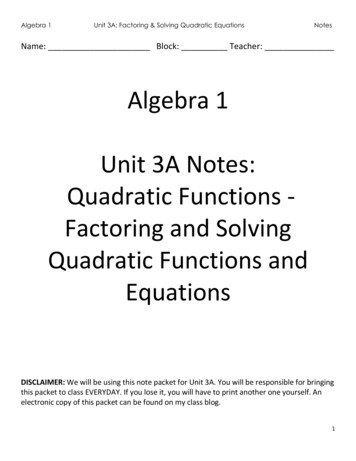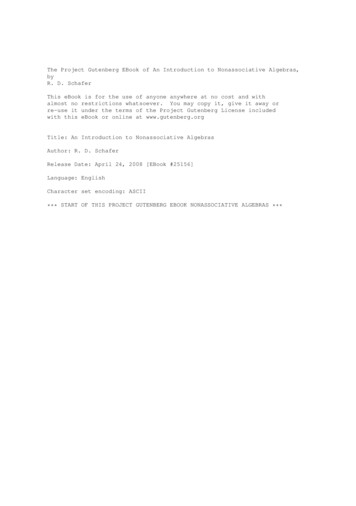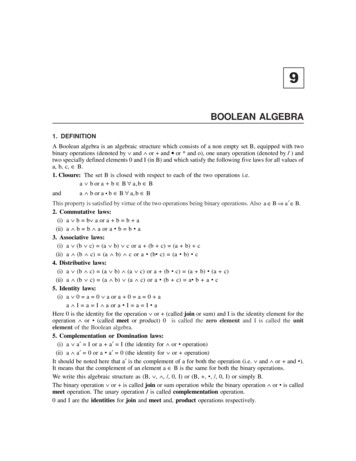
Transcription
Algebra 1Unit 3A: Factoring & Solving Quadratic EquationsNotesName: Block: Teacher:Algebra 1Unit 3A Notes:Quadratic Functions Factoring and SolvingQuadratic Functions andEquationsDISCLAIMER: We will be using this note packet for Unit 3A. You will be responsible for bringingthis packet to class EVERYDAY. If you lose it, you will have to print another one yourself. Anelectronic copy of this packet can be found on my class blog.1
Algebra 1Unit 3A: Factoring & Solving Quadratic EquationsStandardWrite expressions in equivalent forms to solve problemsMGSE9–12.A.SSE.3Choose and produce an equivalent form of an expression to reveal and explainproperties of the quantity represented by the expression.MGSE9–12.A.SSE.3aFactor any quadratic expression to reveal the zeros of the function defined by theexpression.MGSE9–12.A.SSE.3bComplete the square in a quadratic expression to reveal the maximum and minimumvalue of the function defined by the expression.Interpret structure of expressionsMGSE9‐12.A.SSE.2Use the structure of an expression to rewrite it in different equivalent forms. Forexample, see x4 – y4 as (x2)2 – (y2)2, thus recognizing it as a difference of squares thatcan be factored as (x2 – y2)(x2 y2).Create equations that describe numbers or relationshipsMGSE9–12.A.CED.1Create equations and inequalities in one variable and use them to solve problems.Include equations arising from quadratic functions.MGSE9-12.A.CED.2Create quadratic equations in two or more variables to represent relationshipsbetween quantities; graph equations on coordinate axes with labels and scales. (Thephrase “in two or more variables” refers to formulas like the compound interestformula, in which A P(1 r/n)nt has multiple variables.)MGSE9–12.A.CED.4Rearrange formulas to highlight a quantity of interest using the same reasoning as insolving equations. Example: Rearrange area of a circle formula A π r2 to highlightthe radius r.Solve equations and inequalities in one variableMGSE9‐12.A.REI.4Solve quadratic equations in one variable.MGSE9–12.A.REI.4aUse the method of completing the square to transform any quadratic equation in xinto an equation of the form (x – p)2 q that has the same solutions. Derive thequadratic formula from ax2 bx c 0.MGSE9–12.A.REI.4bSolve quadratic equations by inspection (e.g., for x2 49), taking square roots,factoring, completing the square, and the quadratic formula, as appropriate to theinitial form of the equation (limit to real number solutions).NotesLesson2
Algebra 1Unit 3A: Factoring & Solving Quadratic EquationsNotesUnit 3A: Factoring & Solving Quadratic EquationsTable of ContentsAfter completion of this unit, you will be able to Learning Target #1: Factoring Factor the GCF out of a polynomial Factor a polynomial when a 1 Factor a polynomial when a 1 Factor special products (difference of two squares)LessonPageDay 1 - Factoring QuadraticExpressions – GCF4Day 2 - Factoring QuadraticTrinomials, a 16Day 3 - Factoring QuadraticTrinomials, a 18Day 4 - Factoring SpecialProducts10Learning Target #3: Solving by Non Factoring Methods Solve a quadratic equation by finding square roots. Solve a quadratic equation by completing the square. Solve a quadratic equation by using the QuadraticFormula.Day 5 – Solving Quadratics(GCF, a 1, a 1)12Day 6 – SolvingBy Taking Square Roots16Learning Target #4: Solving Quadratic Equations Solve a quadratic equation by analyzing the equation anddetermining the best method for solving. Solve quadratic applicationsDay 7 - Solving by Completingthe Square18Day 8 - Solving by QuadraticFormula20Learning Target #2: Solving by Factoring Methods Solve a quadratic equation by factoring a GCF. Solve a quadratic equation by factoring when a is not 1. Create a quadratic equation given a graph or the zeros ofa function.Timeline for Unit 3AMondayJanuary 27thTuesdayJanuary 28thDay 1- FactoringQuadraticExpressions – GCFWednesday29thDay 2 - FactoringQuadraticTrinomials, a 1Thursday30thDay 3 - FactoringQuadraticTrinomials, a 1February 3rdDay 5a – SolvingQuadratics(GCF, a 1, a 1)4thDay 5b – SolvingQuadratics(GCF, a 1, a 1)5thDay 6a – SolvingBy Taking SquareRoots6thDay 6b – SolvingBy Taking SquareRoots10th11th12thReview SolvingQuadraticsQuiz – SolvingQuadratics13thDay 7b Solving byCompleting theSquareDay 8 Solving byQuadratic FormulaUnit 3A Test ReviewFriday31stDay 4 - FactoringSpecial ProductsQuiz – FactoringQuadratics7thDay 7a Solving byCompleting theSquare14thUnit 3A Test3
Algebra 1Unit 3A: Factoring & Solving Quadratic EquationsNotesDay 1 – Factor by GCFStandard(s):MGSE9–12.A.SSE.3a Factor any quadratic expression to reveal the zeros of the function definedby the expression.What is Factoring?Factoring Finding out which two expressions you together to get one single expression. “Splitting” an expression into a product of simpler expressions. The opposite of expanding or distributing.Numbers have factors:Expressions have factors too:Review: Finding the GCF of Two NumbersCommon Factors Factors that are shared by two or more numbersGreatest Common Factor (GCF) To find the GCF create a factor t-chart for each number and find the largest common factorExample: Find the GCF of 56 and 104Practice: Find the GCF of the following numbers.a. 30, 45b. 12, 544
Algebra 1Unit 3A: Factoring & Solving Quadratic EquationsNotesFinding the GCF of Two ExpressionsTo find the GCF of two expressions, create a factor chart for the two numbers AND expand thevariables. Circle what is common to both.Example: Find the GCF of 36x2y and 16xyPractice: Find the GCF of the following pairs of expressions.1) 15x3 and 9x22) 9a2b2, 6ab3, and 12b3) 8x2 and 7y3Factoring by GCFSteps for Factoring by GCF1. Find the greatest common factor of all the terms.2. The GCF of the terms goes on the outside of the expression and what is leftover goes inparenthesis after the GCF.3. After “factoring out” the GCF, the only that number that divides into each term should be 1.Practice: Factor each expression.1) x2 5xGCF 2)x2 – 8x4)18x2 – 6x5)-2m2 – 8m7)6x3 – 9x2 12x8)4x3 6x2 – 8xGCF GCF GCF GCF GCF 3)28x - 63GCF 6)-9a2 - aGCF 9) 15x3y2 10x2y4GCF 5
Algebra 1Unit 3A: Factoring & Solving Quadratic EquationsNotesDay 2 – Factor Trinomials when a 1Standard(s):MGSE9–12.A.SSE.3a Factor any quadratic expression to reveal the zeros of the function definedby the expression.2nd Degree(Quadratic)Quadratic Trinomials3 Terms(Trinomial)ax 2 bx cFactoring a trinomial means finding two that when multiplied togetherproduce the given trinomial.Skill Preview: “Big X” ProblemsComplete the diamond problems. The top cell contains the product of the numbers in the left andright cells, while the bottom cell contains the sum.6
Algebra 1Unit 3A: Factoring & Solving Quadratic EquationsNotesFactoring using Quadratic Trinomials when a 1Steps for Factoring when a 1Step 1: ALWAYS check to see if you can factor out a GCFStep 2: Draw parentheses for the binomial factors and fill in the variables. Ex ( x)(x)Step 3: Complete a “Big X” and T-chartStep 4: Determine what two numbers can be multiplied to get your “a c” term and added to getyour “b” term. (Use a factor T-chart)Step 5: Fill the factors in the parentheses.Example: Factor the trinomial.x2 6x 8factored form:Factor the following trinomials.a. Factor x2 4x – 32c. Factor x2 – 36b. Factor x2 – 3x – 18d. Factor 2x2 16x 24Remember: You must ALWAYS include the GCF on the outside of the factored form!7
Algebra 1Unit 3A: Factoring & Solving Quadratic EquationsNotesDay 3 – Factor Trinomials with a 1In the previous lesson, we factored polynomials for which the coefficient of the squared term, “a”was always 1. Today we will focus on examples for which a 1.Looking for PatternsWhat do you observe in the following Area Models?Factoring is theofdistributing or multiplying.STEP 1: ALWAYS check to see if you can factor out a GCF.Factor: 2𝑥 2 5𝑥 3STEP 2: Complete a “Big X” and T-chart Determine what two numbers can be multiplied toget your “a c” term and added to get your “b”term.STEP 3: Create a 2x2 Area Model and place your original“a” term in the top left box and “c” term in thebottom right box. Fill the remaining two boxes with the two numbersyou found in “Big X” and place an x after them.STEP 4: Factor out a GCF from each row and columnSTEP 5: Check your factors on the outside by multiplyingthem together to make sure you get all theexpressions in your box.Factored Form:8
Algebra 1Unit 3A: Factoring & Solving Quadratic EquationsNotesFactoring a 1Using the Area Model. Factor the following trinomials.1. 5𝑥 2 14𝑥 3Factored Form:2. 2𝑥 2 17𝑥 30Factored Form:3. 12x2 56x 64Factored Form:4. 6x2 – 40x 24Factored Form:Remember: You must ALWAYS include the GCF on the outside of the factored form!9
Algebra 1Unit 3A: Factoring & Solving Quadratic EquationsNotesDay 4 – Factor Special ProductsStandard(s): MGSE9‐12.A.SSE.2Use the structure of an expression to rewrite it in different equivalent forms. For example, see x4 – y4as (x2)2 – (y2)2, thus recognizing it as a difference of squares that can be factored as (x2 – y2)(x2 y2).Review: Factor the following expressions:a. x2 – 49b. x2 – 25c. x2 – 811. What do you notice about the “a” term?2. What do you notice about the “c” term?3. What do you notice about the “b” term?4. What do you notice about the factored form?The above polynomials are a special pattern type of polynomials; this pattern is called aDifference of Two Squaresa2 – b2 (a – b)(a b)*Always subtraction**Both terms are perfect squares**Always two terms*Can you apply the “Difference of Two Squares” to the following polynomials?a. 9x2 – 49b. 9x2 – 100c. 4x2 – 25d. 16x2 – 1e. x2 25f. 25x2 – 64g. 36x2 – 81h. 49x2 – 910
Algebra 1Unit 3A: Factoring & Solving Quadratic EquationsReview: Factor the following expressions:a. x2 8x 16b. x2 – 2x 1Notesc. x2 – 10x 251. What do you notice about the “a” term?2. What do you notice about the “c” term?3. What do you notice about the “b” term?4. What do you notice about the factored form?The above polynomials are a second type of pattern; this pattern type is called aPerfect Square Trinomialsa2 2ab b2 (a b)2a2 – 2ab b2 (a – b)2Using the perfect square trinomial pattern, see if you can fill in the blanks below:a. x2 36b. x2 - 81c. x2 - 64d. x2 4x e. x2 – 6x f. x2 20x 11
Algebra 1Unit 3A: Factoring & Solving Quadratic EquationsNotesDay 5 – Solving Quadratics (GCF, when a 1, when a not 1)Standard(s):MGSE9‐12.A.REI.4 Solve quadratic equations in one variable.The Main Characteristics of a Quadratic Function A quadratic function always has an exponent of . The standard form of a quadratic equation is The U-shaped graph is called a . The highest or lowest point on the graph is called the . The points where the graph crosses the x-axis are called the. The points where the graph crosses are also called theto the quadratic equation. Aquadratic equation can have , , orsolutions.In this unit, we are going to explore how to solve quadratic equations.Solving a quadratic equation really means:Finding its , , or .Create an equation to represent the following graphs:Zeros: x &Zeros: x &y y 12
Algebra 1Unit 3A: Factoring & Solving Quadratic EquationsNotesZero Product Property and Factored FormZero Product Property The zero-product property is used to an equation when one side is zero andthe other side is a product of binomial factors. The zero product property states that if a· b 0, then a 0 or b 0Examples: Identify the zeros of the functions:a. (x – 2)(x 4) 0b. x(x 4) 0c. (x 3)2 0d. y (x 4)(x 3)f. f(x) 5(x – 4)(x 8)e. y x(x – 9)Solve the following quadratic equations by factoring (GCF) and using the Zero Product Property.1: Factoring & Solving Quadratic Equations - GCFPractice: Solve the following equations by factoring out the GCF.1. 3x2 18x2. -3x2 – 12x 0Factored Form:Factored Form:Zeros:Zeros:13
Algebra 1Unit 3A: Factoring & Solving Quadratic EquationsNotesSolve the following quadratic equations by factoring and using the Zero Product Property.2: Factoring & Solving Quadratic Equations when a 13. y x2 – 6x 94. x2 4x 32Factored Form:Zeros:Factored Form:Zeros:3: Factoring & Solving Quadratic Equations when a not 15. y 5x2 14x – 3Factored Form:Zeroes:6. 2x2 – 8x 42Factored Form:Zeroes:14
Algebra 1Unit 3A: Factoring & Solving Quadratic EquationsNotesGraphic Organizer: Reviewing Methods for FactoringBefore you factor any expression, you must always check for and factor out a Greatest Common Factor (GCF)!GCF (Two Terms)Looks LikeHow to FactorFactor out what is common to both terms (mentallyor list method)ax2 - bxx2 5x x(x 5)18x2 – 6x 6x(3x – 1)-9x2 – x -x(9x 1)Think of what two numbers multiply to get the cterm and add to get the b term (Think of thediamond). You also need to think about the signs:A 1Examplesx2 bx cx2 8x 7 (x 7)(x 1)x2 – 5x 6 (x – 2)(x – 3)2x bx c (x #)(x #)x2 – bx c (x - #)(x - #)x2 – bx – c/x2 bx – c (x #)(x - #)x2 – x – 56 (x 7)(x – 8)Area Model: 3x2 - 5x - 12A not 19x2 – 11x 2 (9x – 2) (x – 1)ax2 bx c2x2 15x 7 (2x 1)(x 7)3x2 – 5x – 28 (2x 7)(x – 4)Difference of Two Squaresx2 – cPerfect SquareTrinomialsFactored Form : (x – 3) (3x 4)x2 bx c“c” is a perfectsquare“b” is double thesquare root of cBoth your “a”and “c” terms should be perfectsquares and since there is no “b” term, it has a valueof 0. You must also be subtracting the a and c terms.Your binomials will be the exact same except foropposite signs.Difference of Squaresa2 – b2 (a b)(a – b)Factor like you would for when a 1x2 – 9 (x 3)(x – 3)x2 – 100 (x 10)(x – 10)4x2 – 25 (2x 5)(2x – 5)x2 – 6x 9 (x – 3)(x – 3) (x – 3)2x2 16x 64 (x 8)(x 8) (x 8)215
Algebra 1Unit 3A: Factoring & Solving Quadratic EquationsNotesDay 6 – Solving Quadratics by Finding Square RootsStandard(s): MGSE9–12.A.REI.4bSolve quadratic equations by inspection (e.g., for x2 49), taking square roots, factoring,completing the square, and the quadratic formula, as appropriate to the initial form of theequation (limit to real number solutions).Review: If possible, simplify the following radicals completely.a. 25b.c. 24125Explore: Solve the following equations for x:a. x2 16b. x2 4c. x2 9d. x2 1Remember: When taking square roots to solve for x, you get a positive and negative answer!Steps for Solving Quadratics by Finding Square Roots1. Add or Subtract any constants that are on the same side of x2.2. Multiply or Divide any constants from x2 terms. “Get x2 by itself”3. Take square root of both sides and set equal to positive and negative roots ( ).Ex: x2 25 x2 25x 5x 5 and x - 5REMEMBER WHEN SOLVING FOR X YOU GET A AND ANSWER!Solve the following for x:1) 𝑥 2 495) 𝑥 2 11 142) 𝑥 2 203) x 2 06) 7𝑥 2 6 574) 3𝑥 2 1087) 4𝑥 2 6 7416
Algebra 1Unit 3A: Factoring & Solving Quadratic EquationsNotesSolving by Finding Square Roots (More Complicated)Steps for Solving Quadratics by Finding Square Roots with Parentheses1. Add or Subtract any constants outside of any parenthesis.2. Multiply or Divide any constants around parenthesis/squared term. “Get ( ) 2 by itself”3. Take square root of both sides and set your expression equal to BOTH the positive and negative root( ). Ex: (x 4)2 252 (x 4) 25(x 4) 5x 4 5 and x 4 -5x 1 and x – 94. Add, subtract, multiply, or divide any remaining numbers to isolate x.REMEMBER WHEN SOLVING FOR X YOU GET A POSITIVE AND NEGATIVE ANSWER!Solve the following for x:1) (𝑥 4)2 814)1(𝑥2 8)2 142) (𝑝 4)2 163) 10(𝑥 7)2 4405) 2(𝑥 3)2 16 486) 3(𝑥 4)2 7 6717
Algebra 1Unit 3A: Factoring & Solving Quadratic EquationsNotesDay 7 – Solving by Completing the SquareStandard(s): MGSE9–12.A.REI.4bSolve quadratic equations by inspection (e.g., for x2 49), taking square roots, factoring,completing the square, and the quadratic formula, as appropriate to the initial form of theequation (limit to real number solutions).Some trinomials form special patterns that can easily allow you to factor the quadratic equation. Wewill look at two special cases:Review: Factor the following trinomials.1. x2 – 6x 92. x2 10x 253. x2 – 16x 64(a) How does the constant term in the binomial relate to the b term in the trinomial?(b) How does the constant term in the binomial relate to the c term in the trinomial?Problems 1-3 are called Perfect Square Trinomials. These trinomials are called perfect squaretrinomials because when they are in their factored form, they are a binomial squared.An example would be x2 12x 36. Its factored form is (x 6)2, which is a binomial squared.But what if you were not given the c term of a trinomial? How could we find it?Complete the square to form a perfect square trinomial and then factor.a. 𝑥 2 12𝑥 b. 𝑧 2 4𝑧 c. 𝑥 2 18𝑥 18
Algebra 1Unit 3A: Factoring & Solving Quadratic EquationsSolving equations by “COMPLETING THE SQUARE”The Equation:STEP 1: Write the equation in the formx2 bx c (Bring the constant to the other side)STEP 2: Make the left-hand side a perfect squareNotesx2 6 x 2 0x 2 6 x 2 𝑥 2 6𝑥 (3)2 2 (3)22 b trinomial by adding to both sides 2 STEP 3: Factor the left side, simplify the right side( x 3)2 7STEP 4: Solve by taking square roots on both sidesx 3 7 and x 3 7x 7 - 3 and x - 7 - 3Group Practice: Solve for x by “Completing the Square”.1. x2 – 6x - 72 02. x2 80 18xX X 3. x2 – 14x – 59 -204. 2x2 – 36x 10 0X X 19
Algebra 1Unit 3A: Factoring & Solving Quadratic EquationsNotesDay 8 - Solving by Quadratic FormulaStandard(s): MGSE9–12.A.REI.4b Solve quadratic equations by inspection (e.g., for x2 49), takingsquare roots, factoring, completing the square, and the quadratic formula, as appropriate to theinitial form of the equation (limit to real number solutions).Exploring the Nature of RootsDetermine the number of real solutions (roots/x-intercepts) for the following graphs:1. 𝑓(𝑥) 𝑥 2 4𝑥 32. 𝑓(𝑥) 𝑥 2 10𝑥 253. 𝑓(𝑥) 𝑥 2 𝑥 1The DiscriminantGiven a quadratic function in standard form: ax bx c 0, where a 0 , The discriminant is found by using: b2 – 4ac The discriminant can be used to determine the real number of solutions for a quadraticequation.2Interpretation of the Discriminant (b2 – 4ac) If b2 – 4ac is positive: If b2 – 4ac is zero: If b2 – 4ac is negative:Practice: Find the discriminant for the previous three functions:a) 𝑓(𝑥) 𝑥 2 4𝑥 3b) 𝑓(𝑥) 𝑥 2 10𝑥 25c) 𝑓(𝑥) 𝑥 2 𝑥 1Discriminant:Discriminant:Discriminant:#of real solutions:#of real solutions:#of real solutions:20
Algebra 1Unit 3A: Factoring & Solving Quadratic EquationsNotesThe Quadratic FormulaWe have learned three methods for solving quadratics: Factoring (Only works if the equation is factorable) Taking the Square Roots (Only works when equations are not in Standard Form) Completing the Square (Only works when a is 1 and b is even)What method do you use when your equations are not factorable, but are in standard form, and amay not be 1 and b may not be even?The Quadratic Formulafor equations in standard form: y ax2 bx c 𝑏 𝑏 2 4𝑎𝑐𝑥 2𝑎x represents the zeros and b2 – 4ac is the discriminantPractice with the Quadratic FormulaFor the quadratic equations below, use the quadratic formula to find the solutions. Write your answerin simplest radical form.1) 𝟒𝒙𝟐 𝟏𝟑𝒙 𝟑 𝟎a b c 2) 9𝑥 2 6𝑥 1 0a b c Discriminant:Discriminant:Solutions:Zeros:21
Algebra 123) 7x 8x 3 0Unit 3A: Factoring & Solving Quadratic Equationsa b c 4) 3𝑥 2𝑥 82Notesa b c Discriminant:Discriminant:X Roots:Determining the Best MethodNon-Factorable MethodsCompleting the Squareax2 bx c 0,when a 1 and b is an even #Finding Square Rootsax2 - c 0Parenthesis in equationExamplesx2 – 6x 11 0x2 – 2x - 20 0Examples2x2 5 95(x 3)2 – 5 20x2 – 36 0Quadratic Formulaax2 bx c 0Any equation in standard formLarge coefficientsExamples3x2 9x – 1 020x2 36x – 17 0Factorable MethodsA 1 & A Not 1 (Factor into 2 Binomials)2ax bx c 0, when a 1ax2 bx c 0, when a 1x2 - c 0Examples3x2 – 20x – 7 0x2 – 3x 2 0x2 5x -6x2 – 25 0GCFax2 bx 0Examples5x2 20x 0x2 – 6x 8x22
Algebra 1 Unit 3A: Factoring & Solving Quadratic Equations Notes 6 Day 2 - Factor Trinomials when a 1 Quadratic Trinomials 3 Terms ax2 bx c Factoring a trinomial means finding two _ that when multiplied together produce the given trinomial. Skill Preview: "Big X" Problems Complete the diamond problems.











